ZOTAC GeForce GTX 780 Ti AMP! Edition Review

We have started a series of NVIDIA GeForce GTX 780 Ti reviews. As you know, It is the fastest gaming videocard of today. And firstly we have tested GeForce GTX 780 Ti built by Zotac.
This review of Zotac’s GeForce GTX 780 Ti AMP! Edition opens up a series of articles about original versions of the GeForce GTX 780 Ti graphics card from at least four different brands. They differ in their GPU and memory frequencies, cooling systems, performance, accessories and price. Of course, it is going to be difficult to find the best product, yet we’ll try to give you as much information as we can for you to be able to make an informed shopping choice. Let’s get started!
Specifications and Recommended Price
The specs and price of the Zotac GeForce GTX 780 Ti AMP! Edition are listed in the following table in comparison with the reference cards Nvidia GeForce GTX 780 Ti, Nvidia GeForce GTX 780 and AMD Radeon R9 290X:
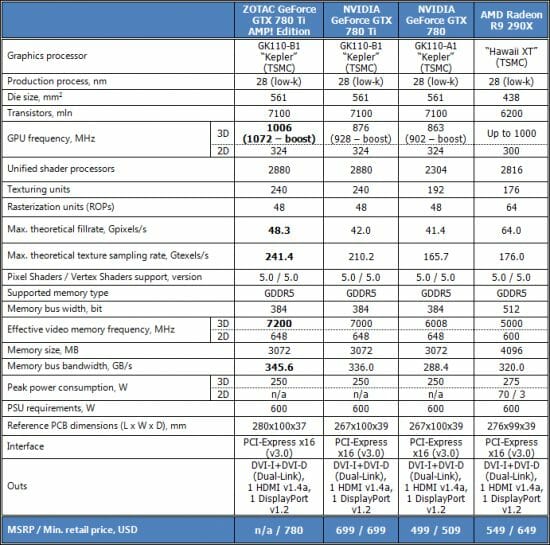
Packaging and Accessories
The graphics card from Zotac comes in a large cardboard box designed in the company’s traditional style. The product’s name on the front of the box is accompanied by icons indicating the card’s pre-overclocked frequencies, extended warranty and exclusive bundled software. There is also a sticker informing you that the card is shipped with free games.
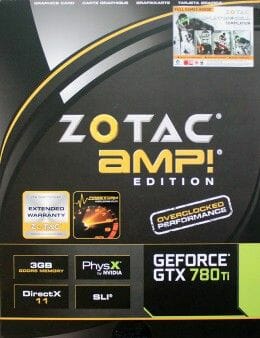
There is a description of the cooling system on the back of the box. It is supposed to be 10°C more efficient and 15 dB quieter than the reference cooler whereas the card itself claims to be 10% faster.
There is a dark cardboard box inside the colorful wrapper. It contains a foam-rubber tray with the graphics card and its accessories. The packaging is simple, yet secure. The accessories include two power adapters, a DVI->D-Sub adapter, a CD with drivers and utilities, a Zotac sticker, and a coupon to download Splinter Cell games.
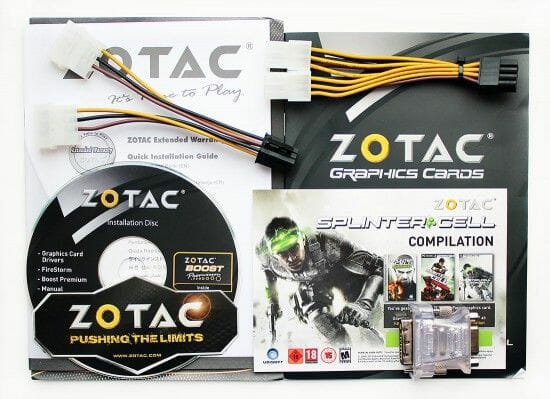
Manufactured in China, the card comes with a 2-year warranty. We couldn’t find out its recommended price whereas its retail price starts from $780.
PCB Design and Features
The GeForce GTX 780 Ti AMP! Edition is designed in Zotac’s black-and-orange color scheme. The face side of the PCB is covered by a cooler with three fans and metallic casing.
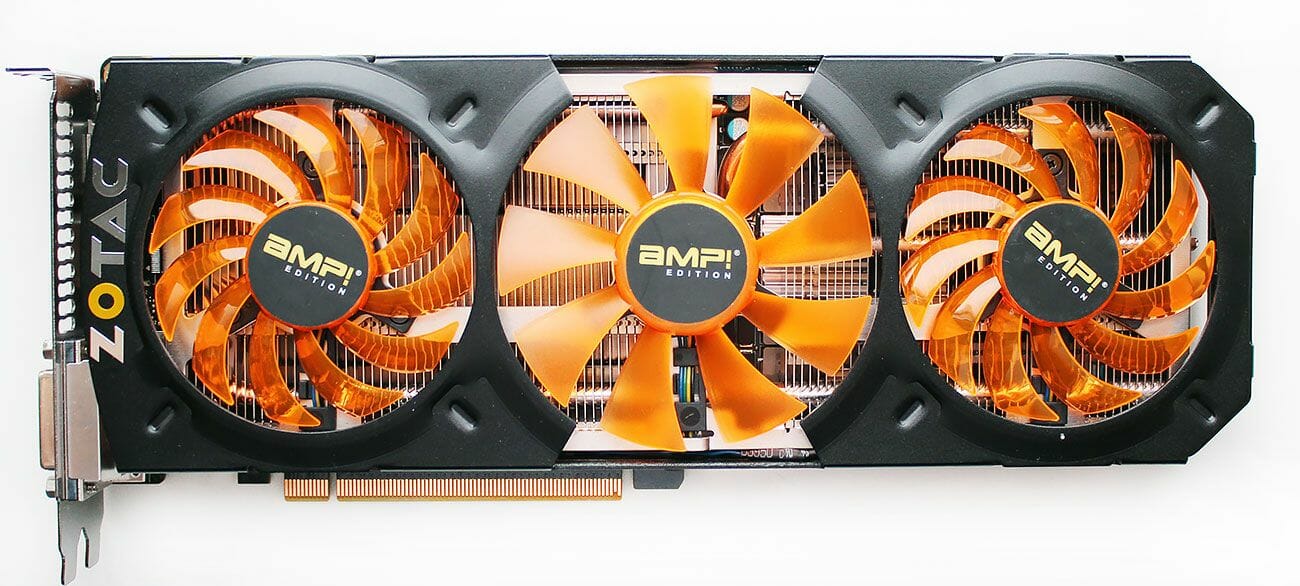
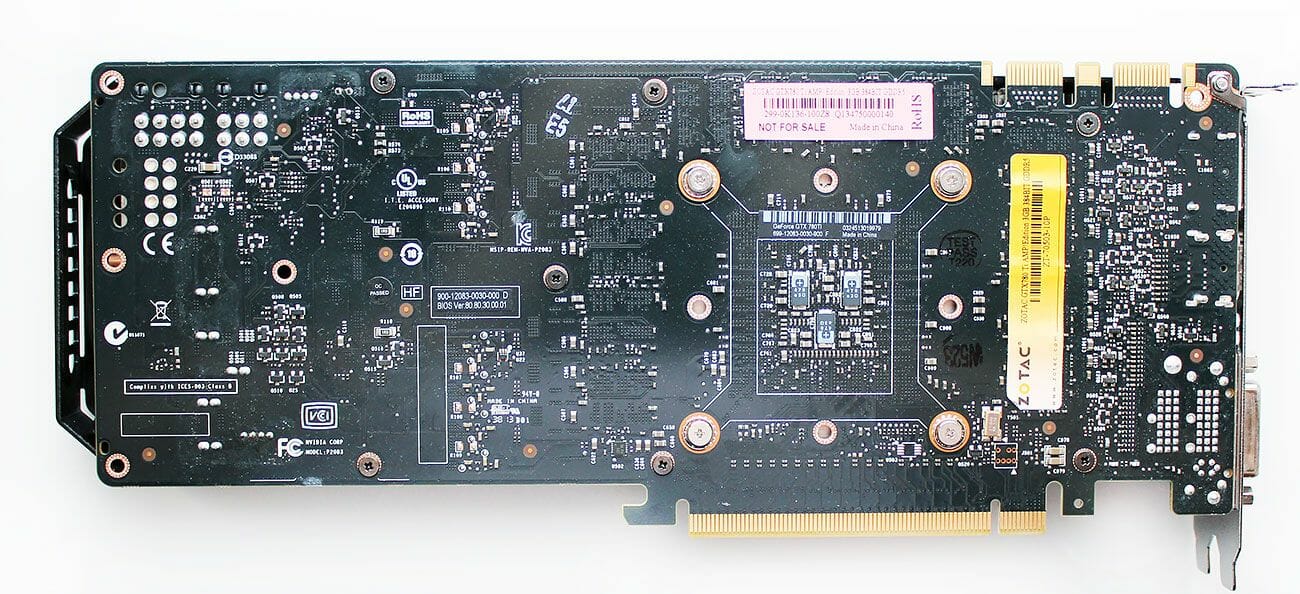
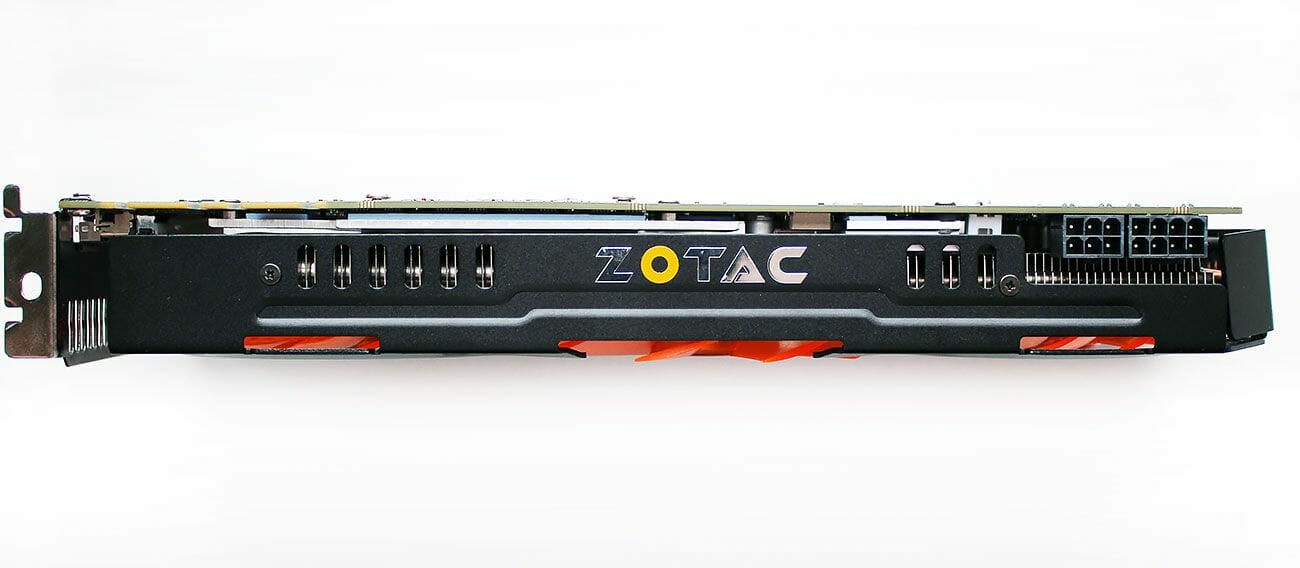
There are vent slits and a silver-yellow name of the manufacturer on the side of the casing. The reverse side of the PCB is exposed. The GeForce GTX 780 Ti AMP! Edition measures 280x100x37 millimeters, which is 13 millimeters longer than the reference GeForce GTX 780 Ti.
Like the reference card, the Zotac has dual-link DVI-I and DVI-D ports, one HDMI 1.4a port, and a DisplayPort 1.2.
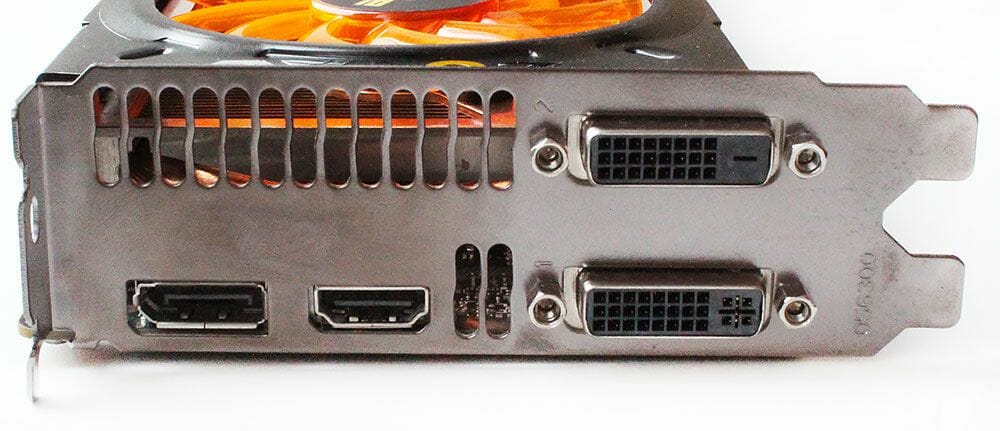
There are power and SLI connectors in their conventional locations:
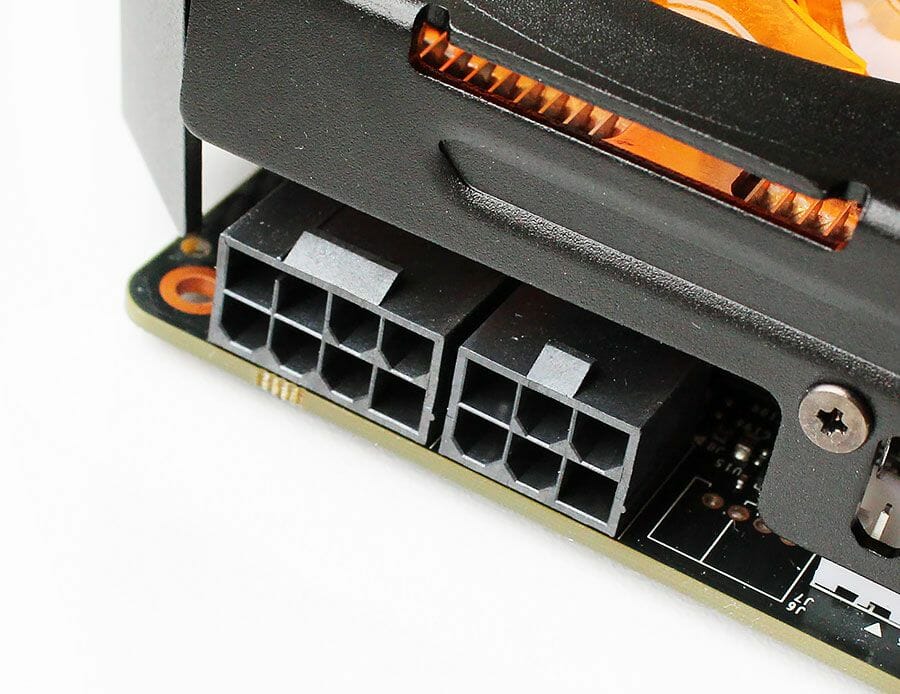
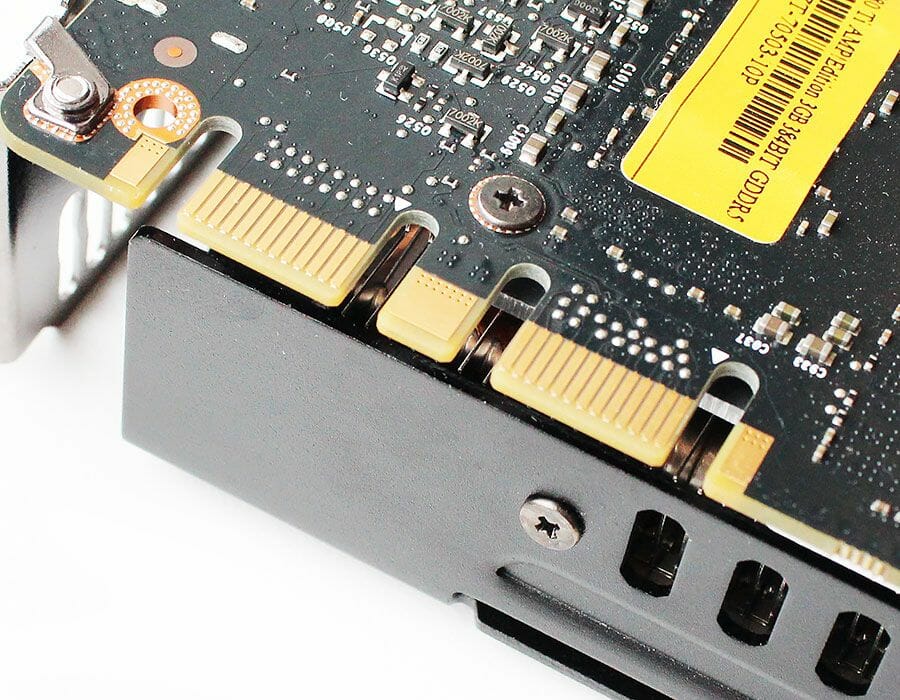
The GeForce GTX 780 Ti AMP! Edition has a specified peak power draw of 250 watts. A 600W PSU is recommended for a computer with one such graphics card. As for SLI support, the GTX 780 Ti can be used even in awfully expensive 4-way SLI configurations.
The PCB copies the reference card’s.
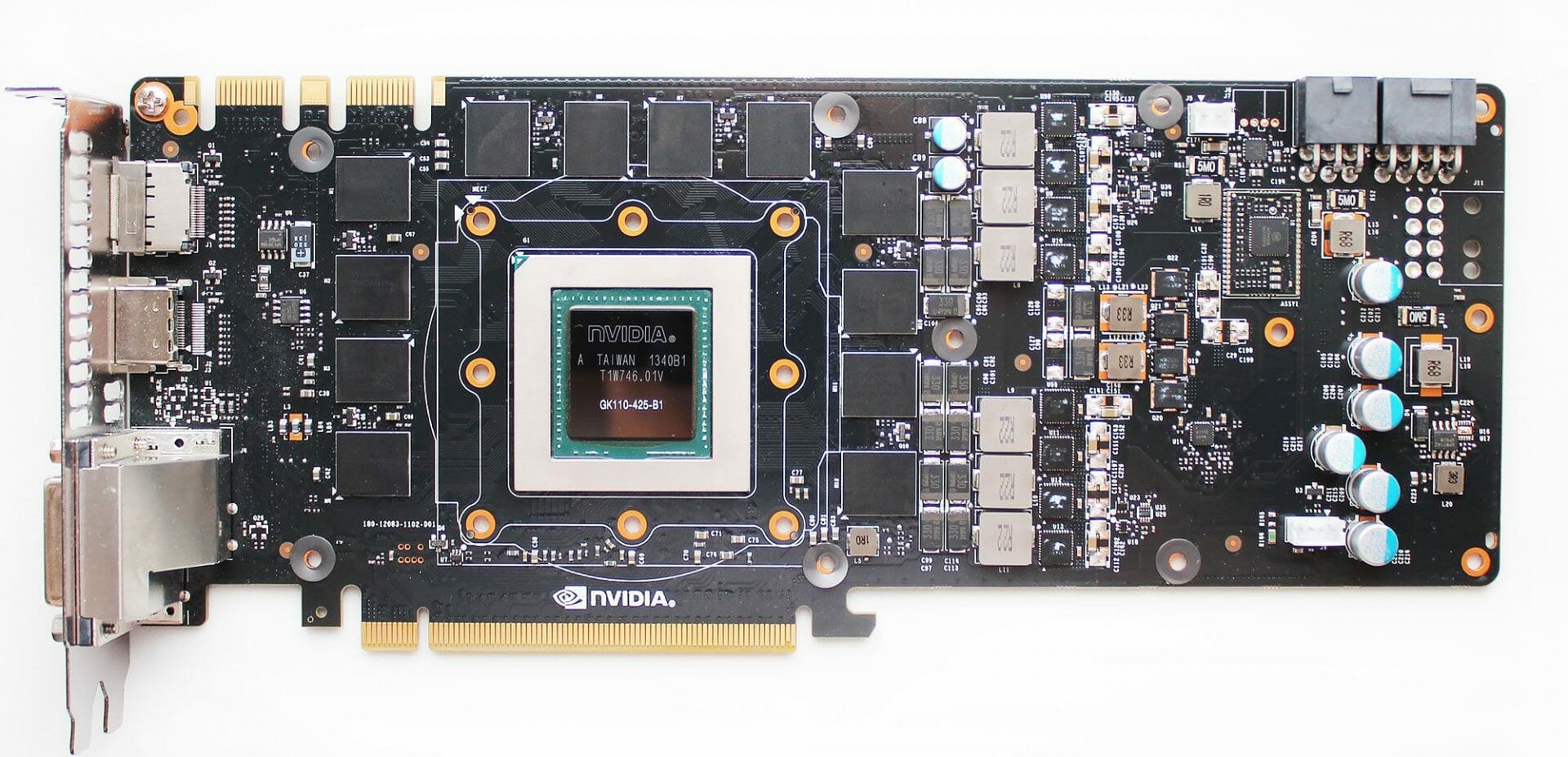
The 8-phase power system is based on DrMOS transistors…
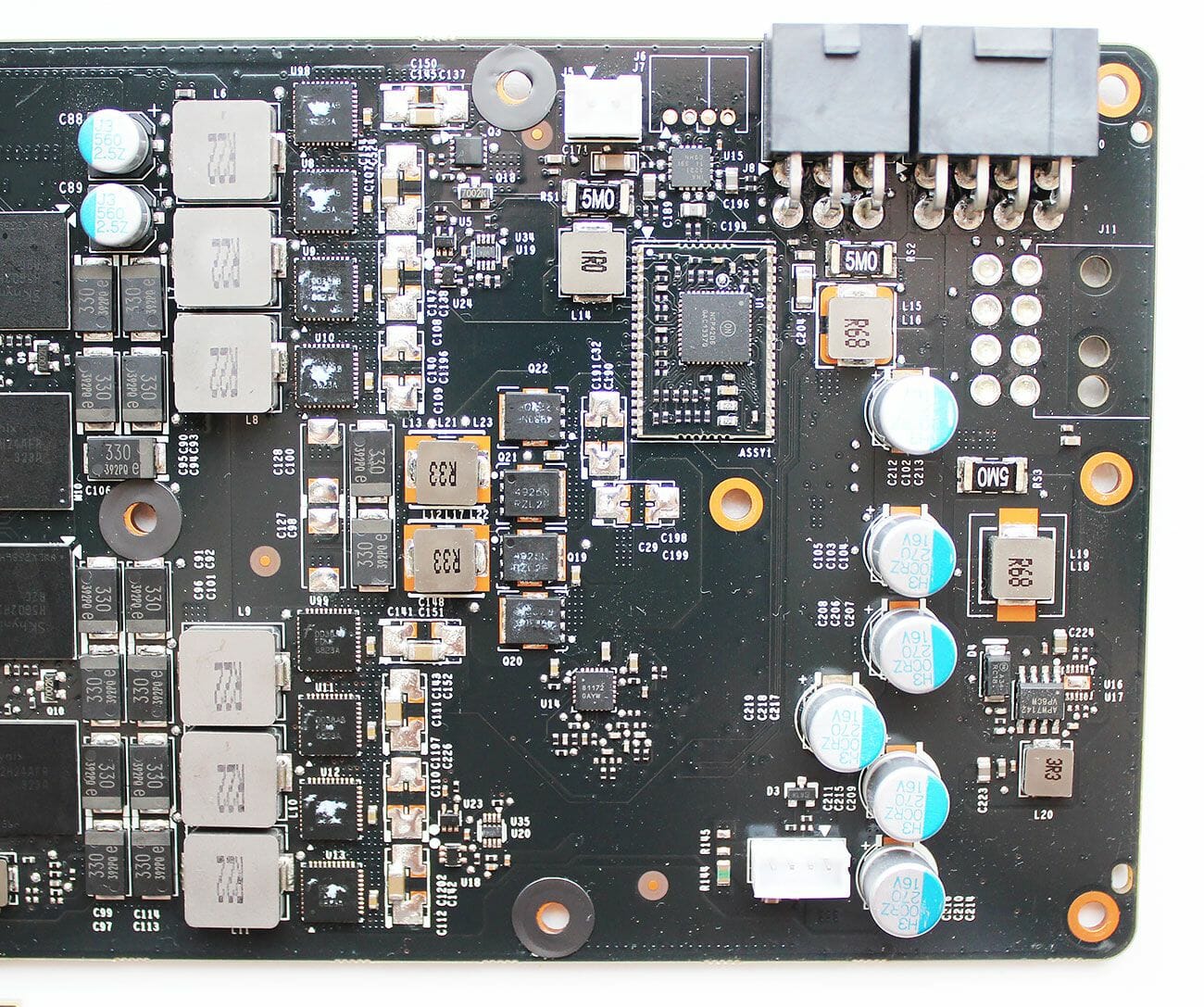
…and is managed by an ON Semiconductor NCP4206 controller.
It’s not the first time we see a GK110, yet it keeps on impressing us with its huge size of 561 sq. mm. The GPU is dated the 40th week of 2013 (early October) and, like the GPU of every other GeForce GTX 780 Ti, is the new revision B1.
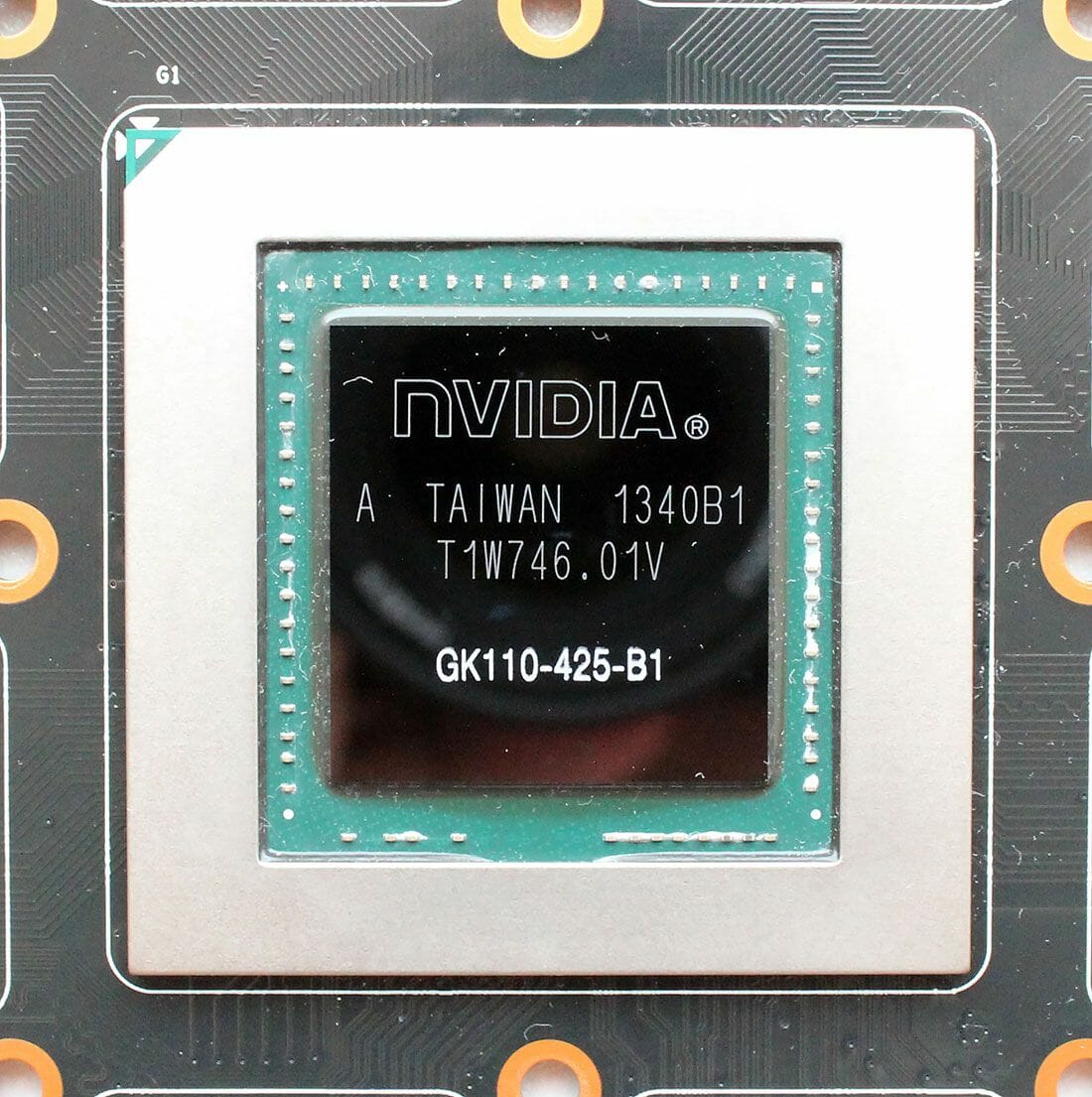
The 3D frequencies of the card’s GPU are 1006/1072 MHz, which is 14.8% above the clock rates of the reference GeForce GTX 780 Ti. That’s some nice factory overclocking, we must admit. The 2D frequency is 324 MHz. The ASIC quality of our GPU sample is 75.4%.
All of the card’s GDDR5 memory chips are soldered to the face side of the PCB. These are 12 FCBGA-packaged H5GQ2H24AFR-R2C chips from SK Hynix. The total memory amount is 3 gigabytes.
This is the fastest serially manufactured memory from SK Hynix, rated for 7000 MHz at 1.5 volts. Zotac pre-overclocks the chips to 7200 MHz, so the peak bandwidth is as high as 345.6 GB/s across the 384-bit bus. That’s a record-breaking number for off-the-shelf graphics cards.
Here is the summary of the card’s features as reported by the GPU-Z utility.
Now we can proceed to testing its original cooling system.
Cooling System: Efficiency and Noise
The ZOTAC GeForce GTX 780 Ti AMP! Edition is equipped with a top-class Triple Silencer cooler. It is a large and heavy design consisting of a main aluminum heatsink, additional heatsinks for the power system and memory chips, three fans, and a decorative metallic casing.
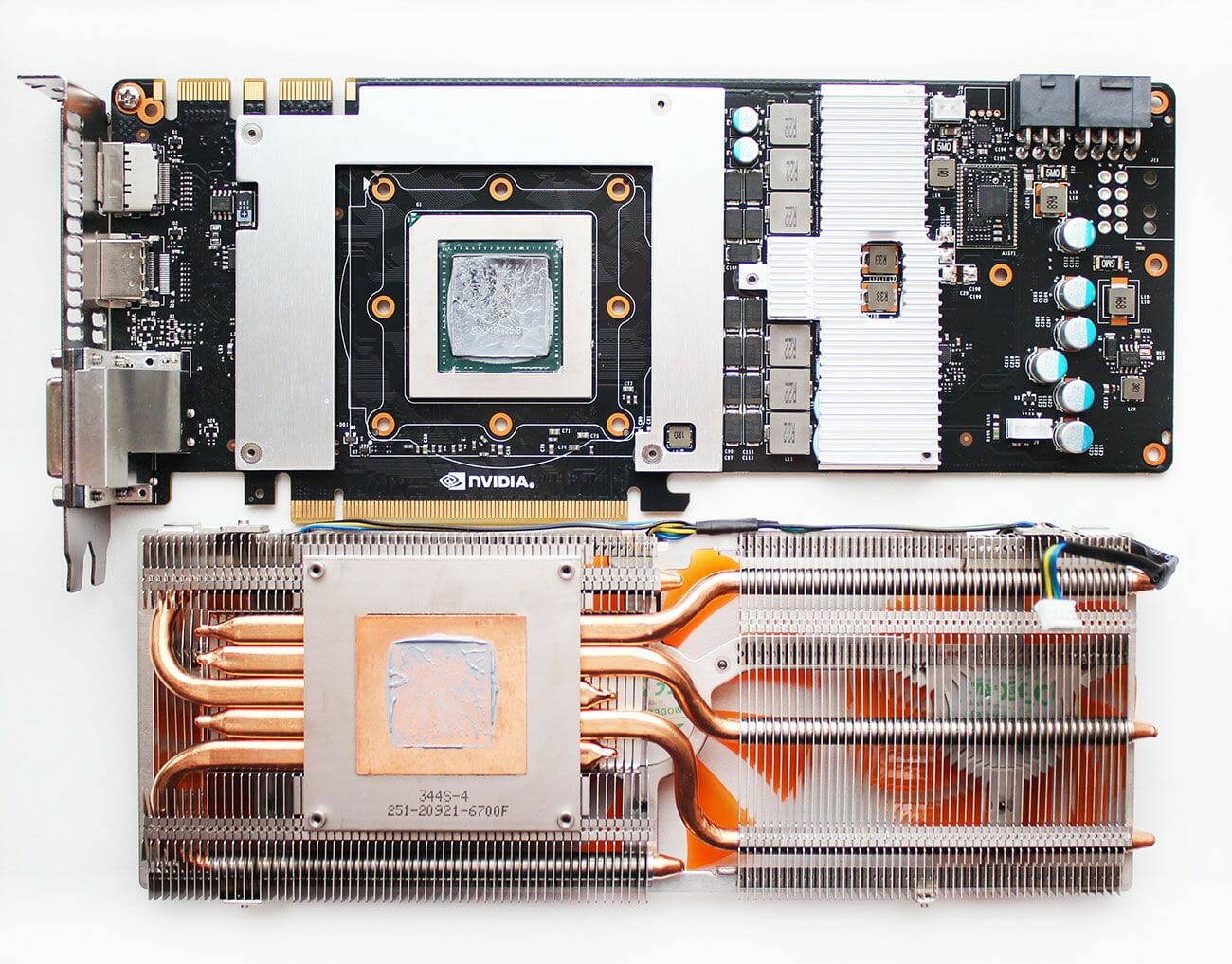
The cooler’s takes heat off the GPU and spreads it through five 6mm heat pipes that stick out of its copper base.
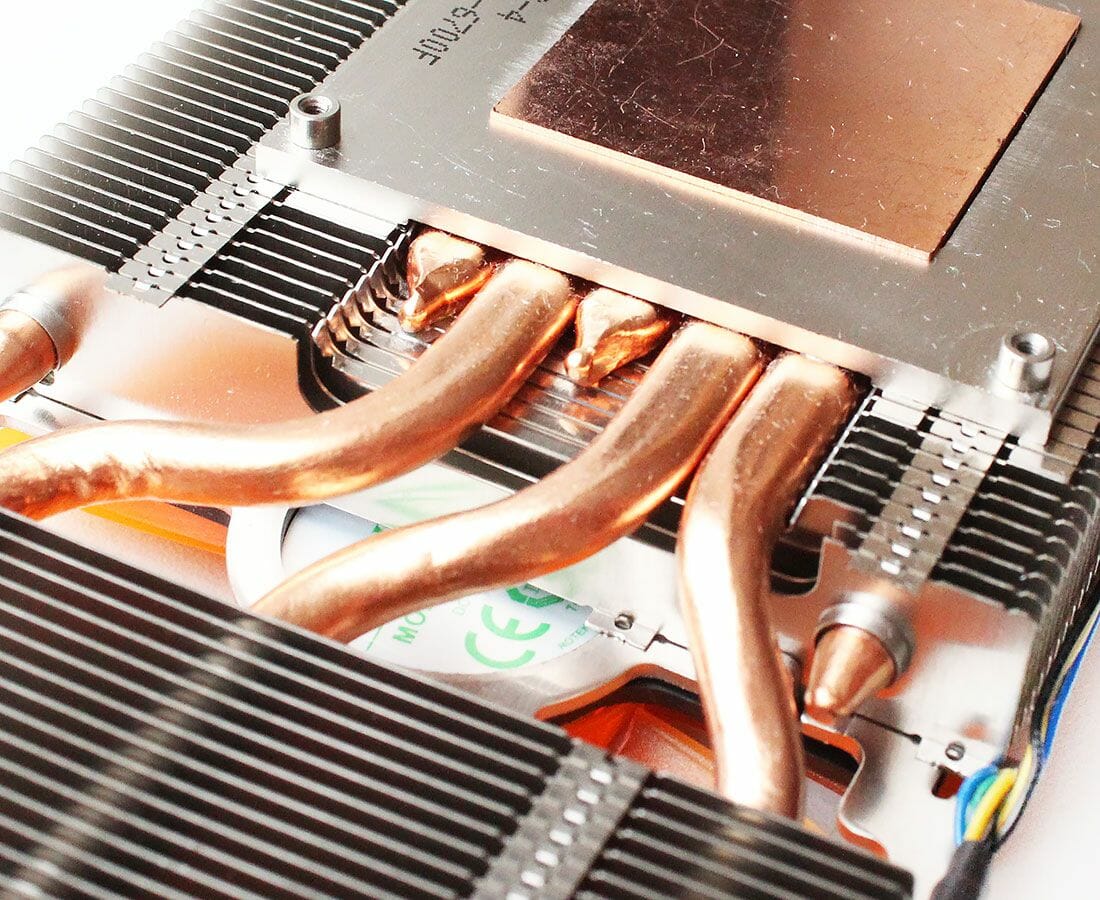
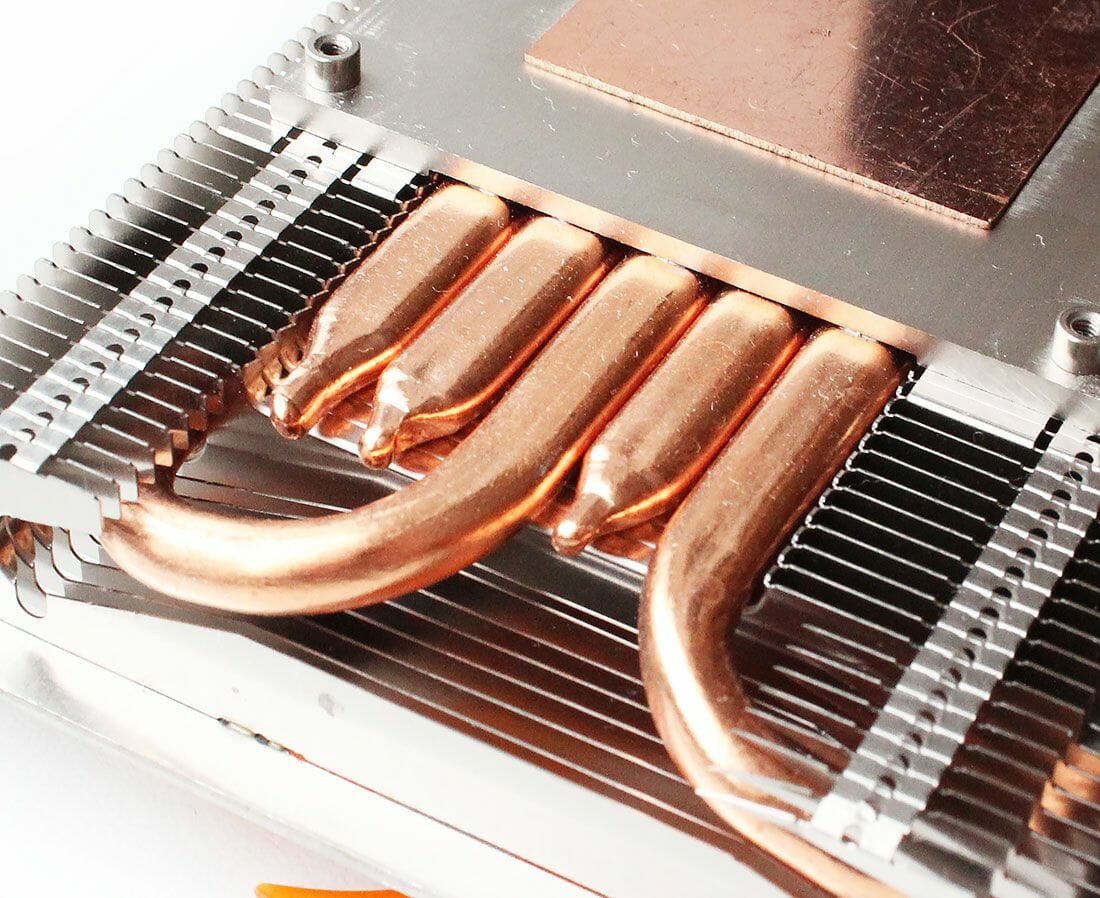
The pipes distribute the heat more or less uniformly within the two comparably sized heatsinks. For better heat transfer, the pipes are soldered to the heatsinks.
The whole arrangement is cooled by three fans from the China-based Apistek. The outermost ones are 74 mm in diameter (the GA81S2U model) whereas the middle one is 86 mm (the GA91S2H model).
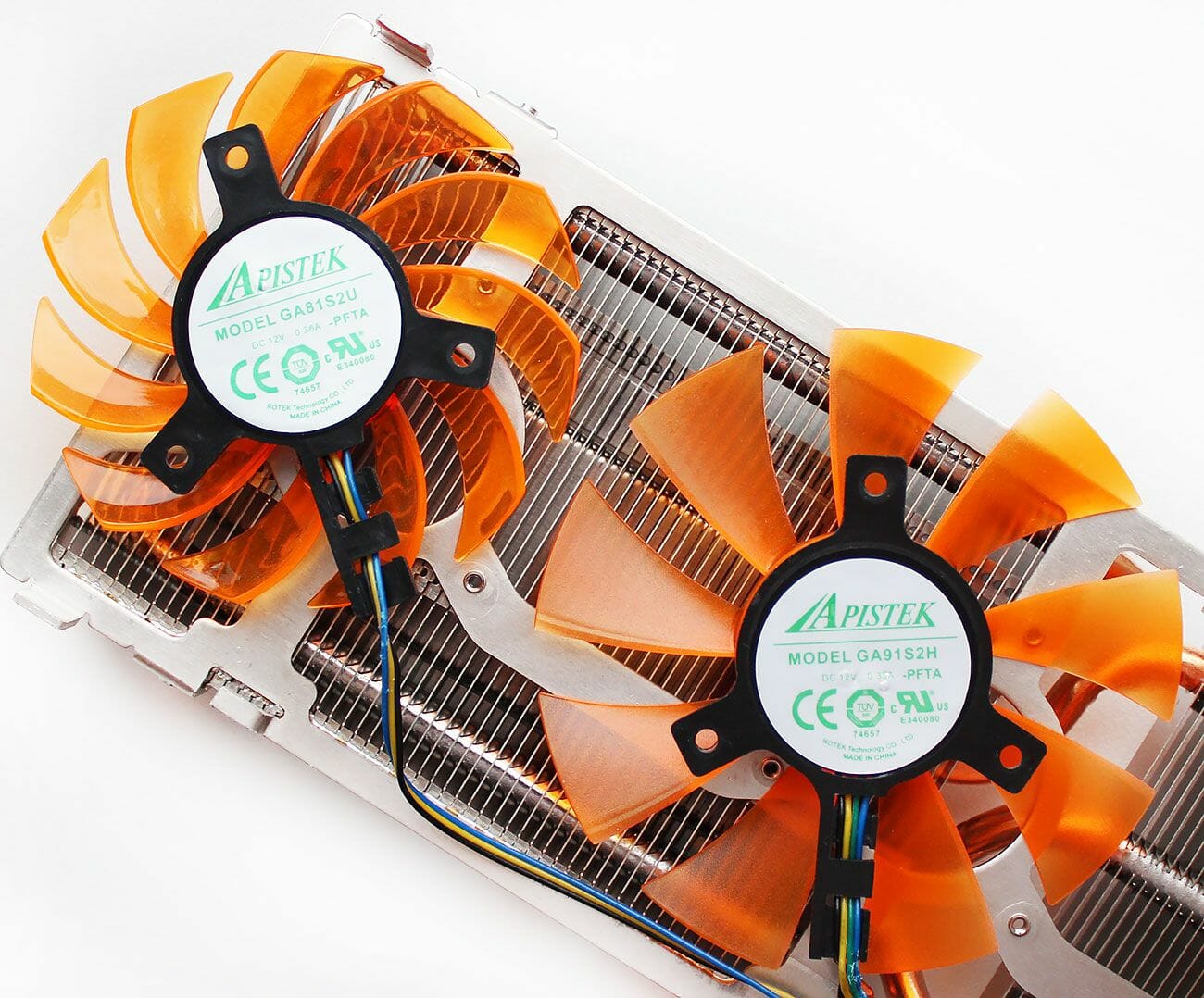
The middle fan is PWM-regulated and used for speed monitoring. The two outermost fans seem to be regulated through voltage all together with the middle fan. The regulation range is 1000 to 3300 RPM.
The memory chips are cooled by an aluminum plate with thermal pads. There is an aluminum heatsink, about 6 mm in height, installed on the power system components.
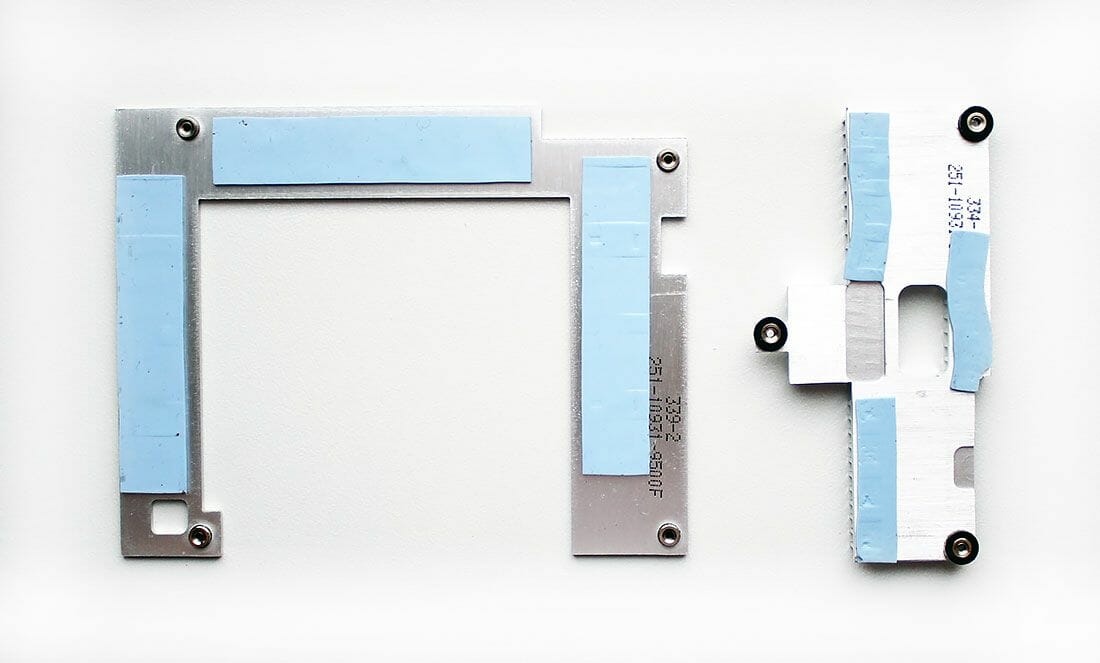
To measure the temperature of the ZOTAC GeForce GTX 780 Ti AMP! Edition we ran Aliens vs. Predator (2010) five times at the maximum visual quality settings, at a resolution of 2560×1440 pixels, with 16x anisotropic filtering and with 4x MSAA.
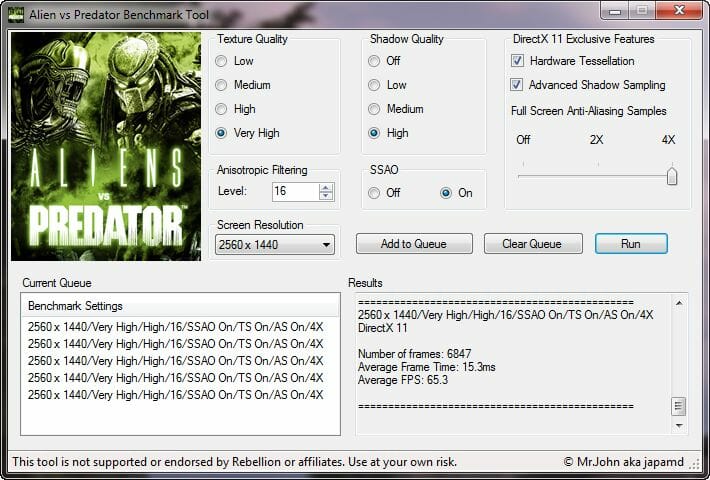
We used MSI Afterburner 3.0.0 beta 17 and GPU-Z version 0.7.5 to monitor temperatures inside the closed computer case. The computer’s configuration is detailed in the following section of our review. All tests were performed at about 25°C room temperature.
In the automatic fan regulation mode the GPU of the reference GeForce GTX 780 Ti would get as hot as 86°C with the radial fan rotating at 3100 RPM. The Zotac’s GPU, although clocked 130 MHz higher, is only 70°C hot while its fans rotate at only 2160 RPM.
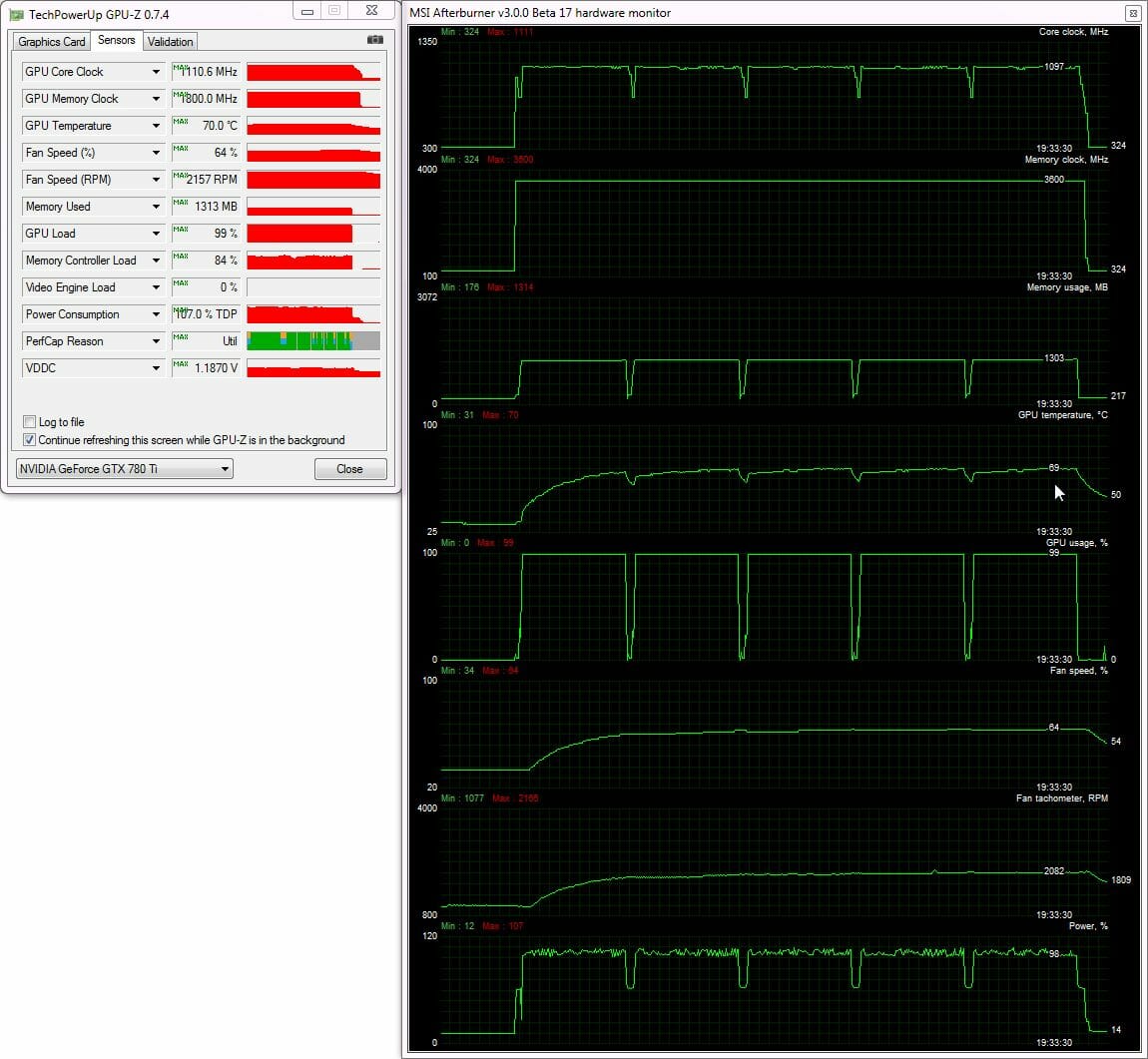
We guess that’s just a perfect result for such a fast single-GPU graphics card and it justifies the higher price of the original version from Zotac. You can also set the fans at their maximum speed and drop the peak GPU temperature down by almost 10°C:
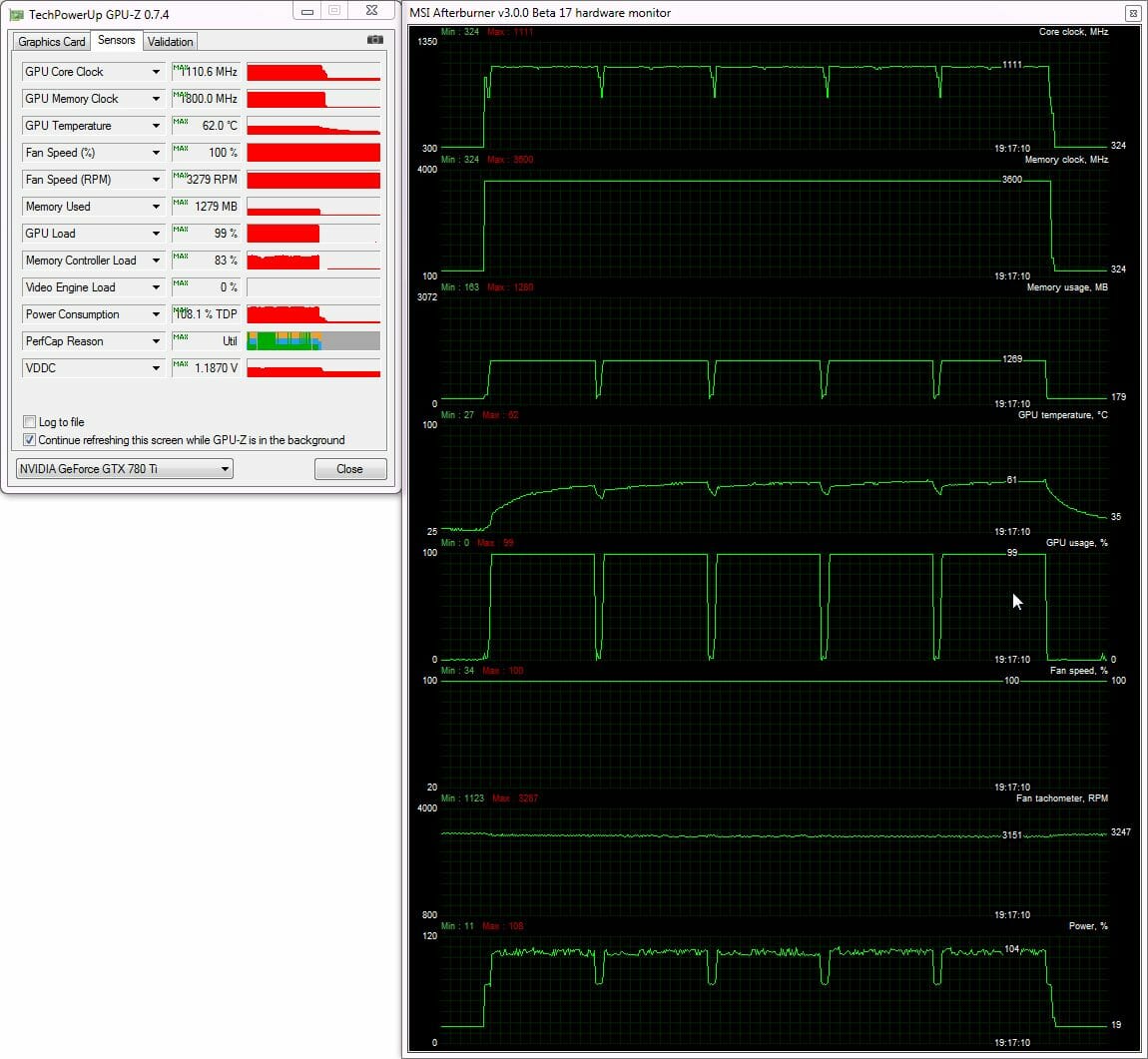
Of course, the ZOTAC GeForce GTX 780 Ti AMP! Edition is going to be rather noisy in this case. Let’s check out how noisy, exactly.
We measured the level of noise using an electronic noise-level meter CENTER-321 in a closed and quiet room about 20 sq. meters large. The noise-level meter was set on a tripod at a distance of 15 centimeters from the graphics card which was installed on an open testbed. The mainboard with the graphics card was placed at an edge of a desk on a foam-rubber tray. The bottom limit of our noise-level meter is 29.8 dBA whereas the subjectively comfortable (not low, but comfortable) level of noise when measured from that distance is about 36 dBA. The speed of the graphics card’s fans was being adjusted by means of a controller that changed the supply voltage in steps of 0.5 V.
In this test we’ll compare the Zotac GeForce GTX 780 Ti AMP! Edition with the reference Nvidia GeForce GTX 780 Ti and AMD Radeon R9 290X, as well as with the original EVGA GeForce GTX 780 Superclocked which features the ACX cooler. The vertical dotted lines mark the top speed of the fans in the automatic regulation mode. Here are the results:
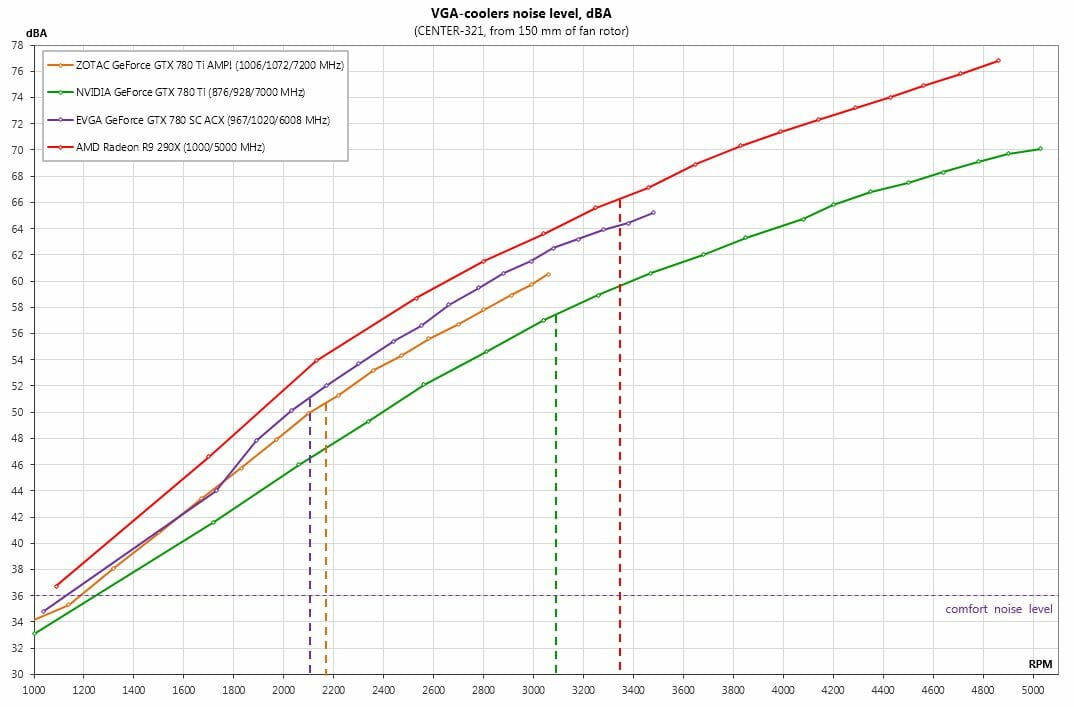
Despite the fact that the Zotac GeForce GTX 780 Ti AMP! Edition is the quietest card in this test and even beats the EVGA GeForce GTX 780 Superclocked ACX in this respect, we cannot call it really quiet. It is audible against the background noise of a working computer in 3D applications. While not really comfortable in terms of noisiness, the new card is an obvious improvement on the reference GeForce GTX 780 Ti.
By the way, if you think that graphics cards of this class have such a high level of heat dissipation that they cannot be quiet at all, we will prove the contrary in an upcoming review of another original GTX 780 Ti.
As for the Zotac Triple Silencer, its fans and heatsink plates do not rattle or anything. The cooler is overall a well-designed and high-quality thing.
Overclocking Potential
Our Zotac GeForce GTX 780 Ti AMP! Edition turned out to be excellent in terms of GPU overclocking but its memory wasn’t that good. We managed to increase its GPU and memory clock rates by 155 and 490 MHz, respectively.
The resulting GPU clock rates were 1161/1227 MHz (+15.4%) whereas the graphics memory worked at 7692 MHz (+6.8%).
Moreover, the GPU frequency would peak up to 1255 MHz in 3D applications, which is an excellent result for a top-end Kepler-based GPU. This achievement is even more impressive considering the temperature factor:
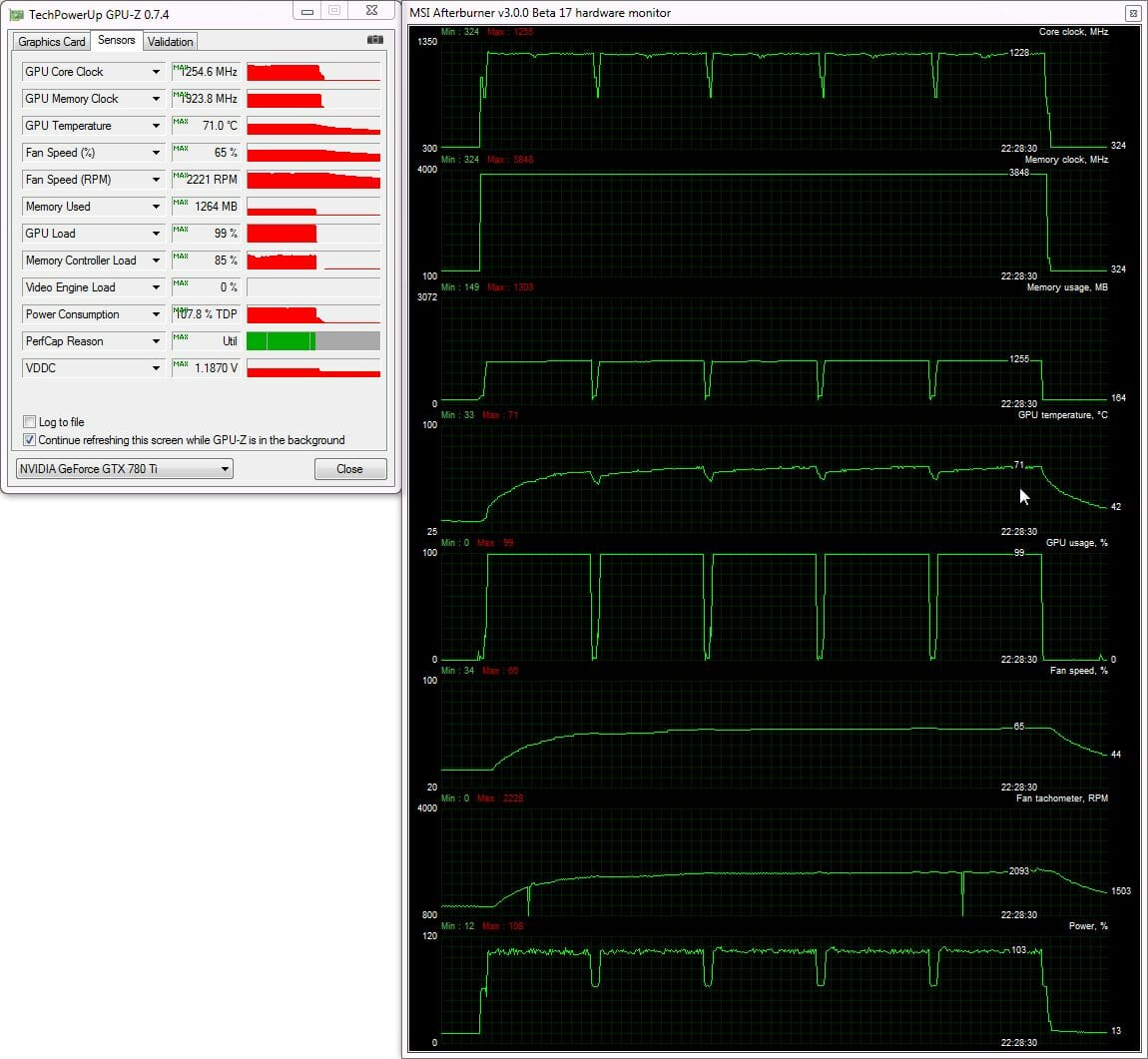
When overclocked, the Zotac gets a mere 1°C hotter (71°C) and the top speed of its fans is only 70 RPM higher. So, the pre-overclocked GeForce GTX 780 Ti AMP! Edition can be overclocked even further, at least in terms of GPU frequency. Just a perfect result!
Testbed and Methods
Here is the list of components we use in our testbed.
- Mainboard: Intel Siler DX79SR (Intel X79 Express, LGA 2011, BIOS 0590 dated 17.07.2013)
- CPU: Intel Core i7-3970X Extreme Edition 3.5/4.0 GHz (Sandy Bridge-E, C2, 1.1 V, 6x256KB L2 cache, 15MB L3 cache)
- CPU cooler: Phanteks PH-TC14PЕ (2xCorsair AF140 fans, 900 RPM)
- Thermal grease: ARCTIC MX-4
- Graphics cards:
- Nvidia GeForce GTX 780 Ti 3GB (876/928/7000 MHz)
- EVGA GeForce GTX 780 Superclocked ACX 3GB (863/916/6008 MHz; and overclocked to 1032/1085/7348 MHz)
- AMD Radeon R9 290X 4GB (1000/5000 MHz)
- AMD Radeon R9 290 4GB (947/5000 MHz)
- System memory: DDR3 4x8GB G.SKILL TridentX F3-2133C9Q-32GTX (XMP: 2133 MHz, 9-11-11-31, 1.6 volts)
- System disk: SSD 256GB Crucial m4 (SATA 6 Gbit/s, CT256M4SSD2, BIOS v0009)
- Games/software disk: Western Digital VelociRaptor (SATA-2, 300 GB, 10000 RPM, 16 MB cache, NCQ) in a Scythe Quiet Drive 3.5″ enclosure
- Backup disk: Samsung Ecogreen F4 HD204UI (SATA-2, 2 TB, 5400 RPM, 32 MB cache, NCQ)
- Computer case: Antec Twelve Hundred (front panel: three Noiseblocker NB-Multiframe S-Series MF12-S2 fans at 1020 RPM; back panel: two Noiseblocker NB-BlackSilentPRO PL-1 fans at 1020 RPM; top panel: one preinstalled 200mm fan at 400 RPM)
- Control & monitoring panel: Zalman ZM-MFC3
- Power supply: Corsair AX1200i (1200 W), 120mm fan
- Monitor: 27″ Samsung S27A850D (DVI-I, 2560×1440, 60 Hz)
The Zotac card will be compared with the top-end single-GPU reference cards Nvidia GeForce GTX 780 Ti ($699) and AMD Radeon R9 290X ($649) working at their standard clock rates:
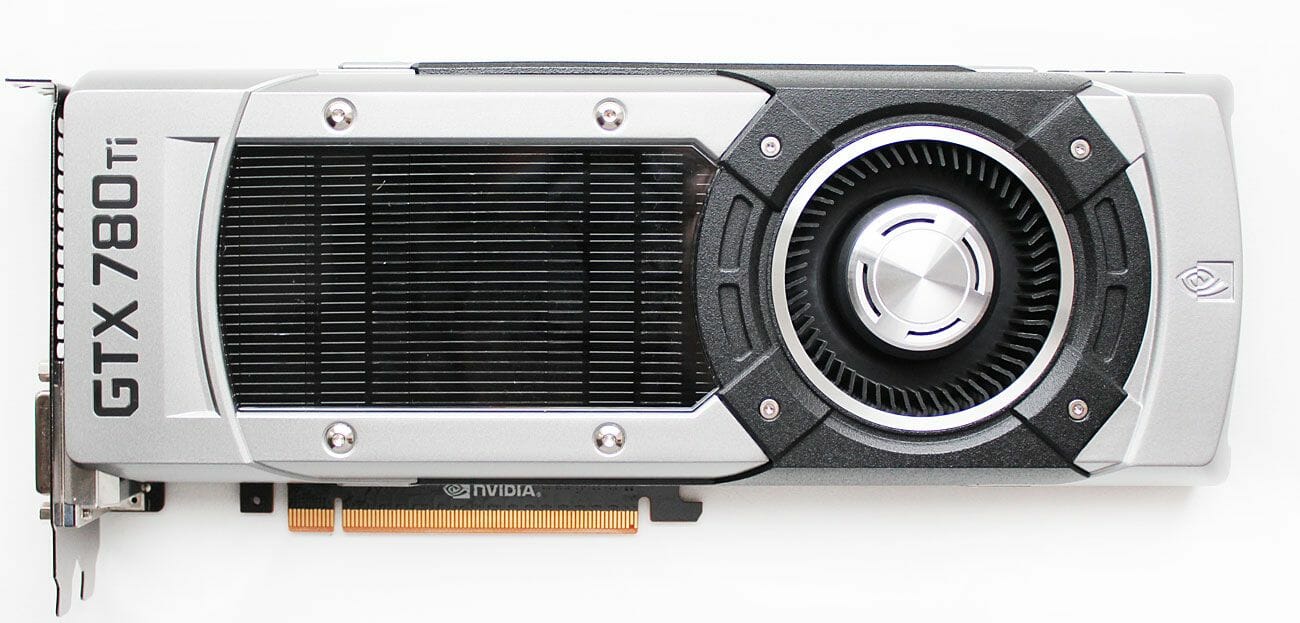
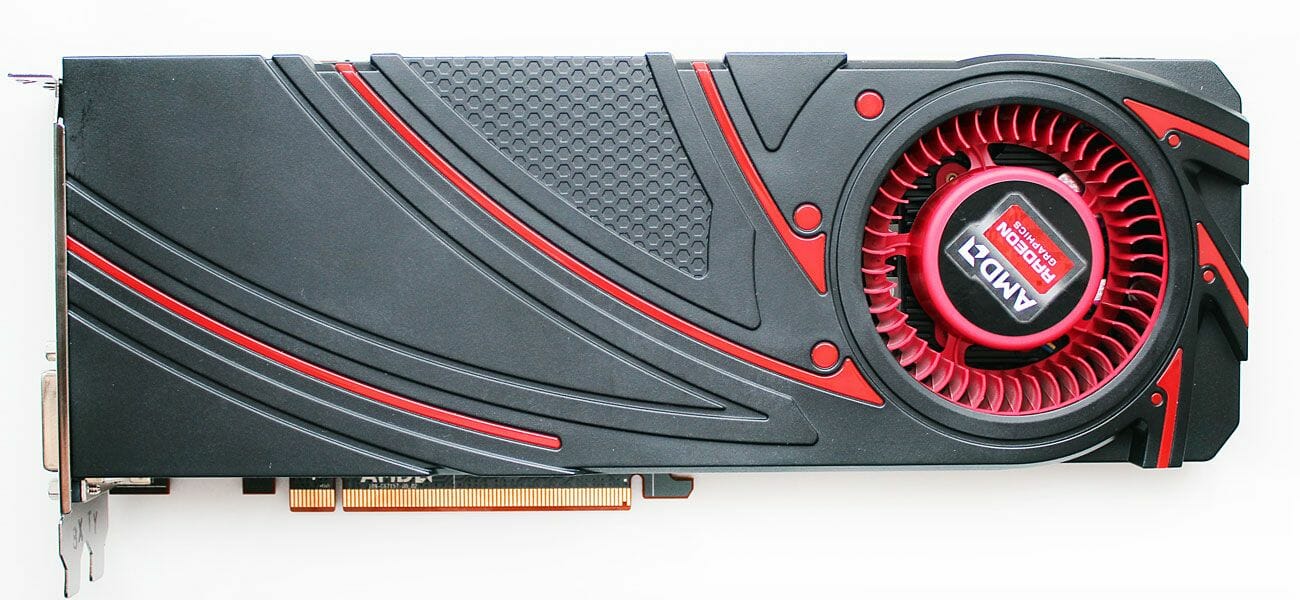
We also include EVGA’s original GeForce GTX 780 Superclocked ACX 3GB (at the reference GTX 780 clock rates as well as with maximum overclocking) and a reference AMD Radeon R9 290 4GB (without overclocking).
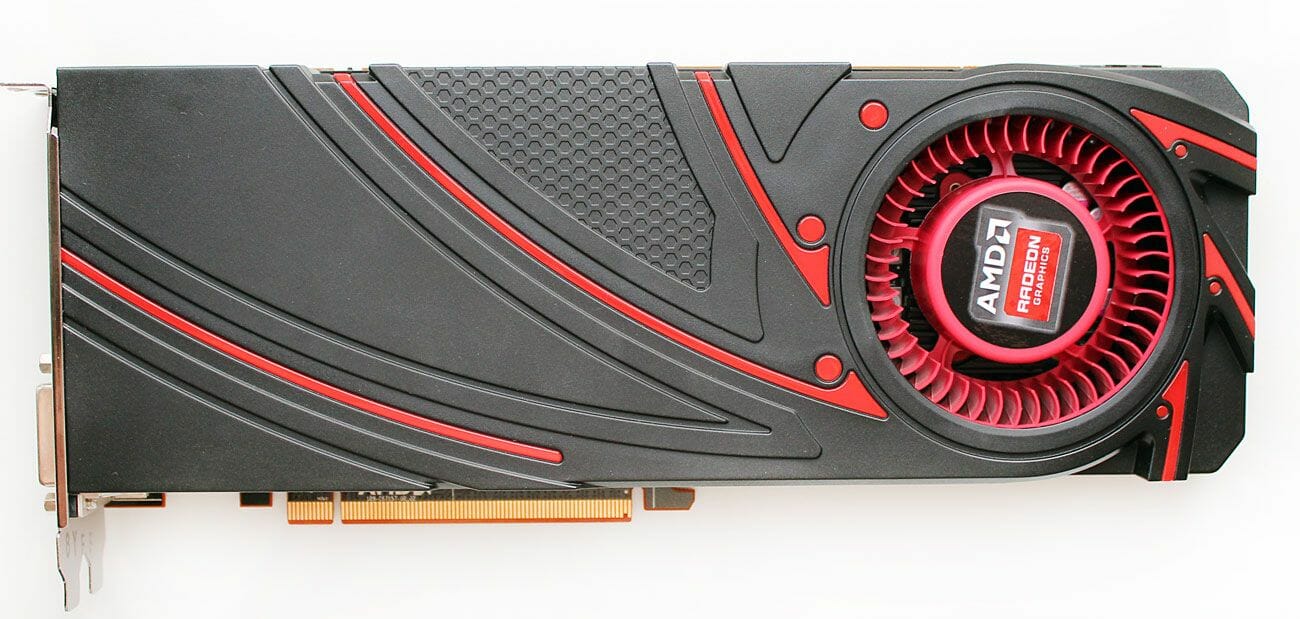
In order to lower the dependence of the graphics cards’ performance on the overall platform speed, we overclocked our 32nm six-core CPU to 4.8 GHz by setting its frequency multiplier at x48 and enabling Load-Line Calibration. The CPU voltage was increased to 1.38 volts in the mainboard’s BIOS:
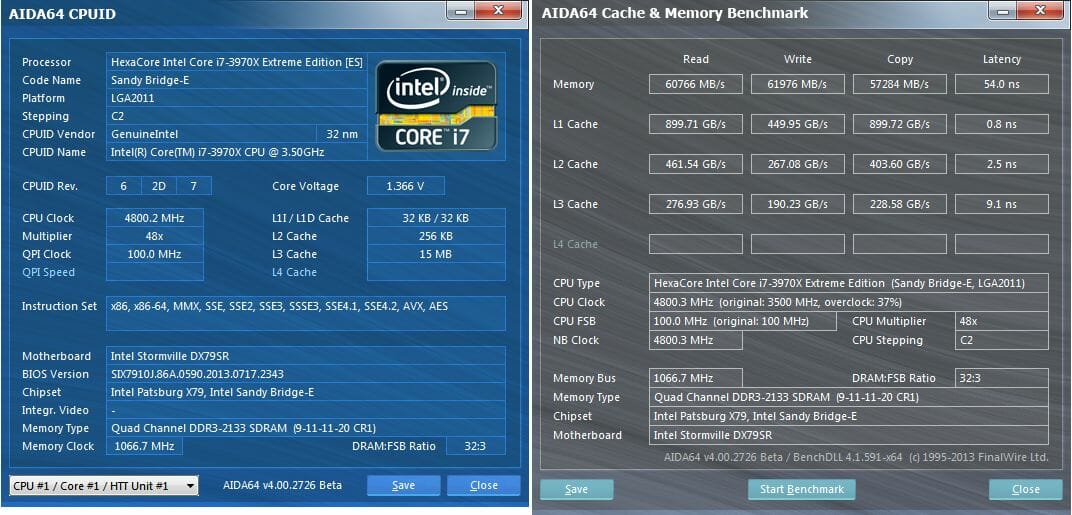
Hyper-Threading was turned on. We used 32 GB of system memory at 2.133 GHz with timings of 9-11-11-20_CR1 and voltage of 1.6125 volts.
The testbed ran Microsoft Windows 7 Ultimate x64 SP1 with all critical updates installed. We used the following drivers:
- Intel Chipset Drivers – 9.4.4.1006 WHQL dated 21.09.2013
- DirectX End-User Runtimes, dated 30 November 2010
- AMD Catalyst 13.12 WHQL (13.251.0.0) dated 18.12.2013
- GeForce 331.93 Beta dated 27.11.2013
We benchmarked the graphics cards’ performance at two display resolutions: 1920×1080 and 2560×1440 pixels. There were two visual quality modes: “Quality+AF16x” means the default texturing quality in the drivers + 16x anisotropic filtering whereas “Quality+ AF16x+MSAA 4x(8x)” means 16x anisotropic filtering and 4x or 8x antialiasing. In some games we use antialiasing algorithms other than MSAA as indicated below and in the diagrams. We enabled anisotropic filtering and full-screen antialiasing from the game’s menu. If the corresponding options were missing, we changed these settings in the Control Panels of the Catalyst and GeForce drivers. We also disabled Vsync there. There were no other changes in the driver settings.
The graphics cards were tested in 2 benchmarks and 13 games updated to the latest versions.
- 3DMark (2013) (DirectX 9/11) version 1.2.250.0: Cloud Gate, Fire Strike and Fire Strike Extreme scenes.
- Unigine Valley Bench (DirectX 11) version 1.0: maximum visual quality settings, 16x AF and/or 4x MSAA, 1920×1080.
- Total War: SHOGUN 2 – Fall of the Samurai (DirectX 11) version 1.1.0: integrated benchmark (the Sekigahara battle) with maximum visual quality settings and 8x MSAA.
- Sniper Elite V2 Benchmark (DirectX 11) version 1.05: Adrenaline Sniper Elite V2 Benchmark Tool v1.0.0.2 BETA with maximum graphics quality settings (“Ultra” profile), Advanced Shadows: HIGH, Ambient Occlusion: ON, Stereo 3D: OFF, Supersampling: OFF, two sequential runs of the test.
- Sleeping Dogs (DirectX 11) version 1.5: Adrenaline Sleeping Dogs Benchmark Tool v1.0.2.1 with maximum image quality settings, Hi-Res Textures pack installed, FPS Limiter and V-Sync disabled, two consecutive runs of the built-in benchmark with quality antialiasing at Normal and Extreme levels.
- Hitman: Absolution (DirectX 11) version 1.0.447.0: built-in test with Ultra settings, enabled tessellation, FXAA and global lighting.
- Crysis 3 (DirectX 11) version 1.2.0.1000: maximum visual quality settings, Motion Blur – Medium, lens flares – on, FXAA and MSAA 4x, two consecutive runs of a scripted scene from the beginning of the “Swamp” mission (110 seconds long).
- Tomb Raider (2013) (DirectX 11) version 1.1.748.0: Adrenaline Benchmark Tool, “Ultra” image quality settings, V-Sync disabled, FXAA and 2x SSAA antialiasing enabled, TessFX technology activated, two consecutive runs of the in-game benchmark.
- BioShock Infinite (DirectX 11) version 1.1.24.21018: Adrenaline Action Benchmark Tool with “Ultra” and “Ultra+DOF” quality settings, two consecutive runs of the in-game benchmark.
- Metro: Last Light (DirectX 11) version 1.0.0.15: we used the built-in benchmark for two consecutive runs of the D6 scene. All image quality and tessellation settings were at “Very High”, Advanced PhysX technology enabled, with and without SSAA antialiasing.
- GRID 2 (DirectX 11) version 1.0.85.8679: we used the built-in benchmark, the visual quality settings were all at their maximums, the tests ran with and without MSAA 8x antialiasing with eight cars on the Chicago track.
- Company of Heroes 2 (DirectX 11) version 3.0.0.11811: two consecutive runs of the integrated benchmark at maximum image quality and physics effects settings.
- Total War: Rome II (DirectX 11) version 1.8.0 build 8891.481024: Extreme quality, V-Sync disabled, SSAA enabled, two consecutive runs of the integrated benchmark.
- Batman: Arkham Origins (DirectX 11) version 1.0 update 8: Ultra visual quality, V-Sync disabled, all the effects enabled, all DX11 Enhanced features enabled, Hardware Accelerated PhysX = Normal, two consecutive runs of the in-game benchmark.
- Battlefield 4 (DirectX 11) version 1.4: Ultra settings, two successive runs of a scripted scene from the beginning of the “Tashgar” mission (110 seconds long).
We publish the bottom frame rate for games that report it. Each test was run twice, the final result being the best of the two if they differed by less than 1%. If we had a larger difference, we reran the test at least once again to get repeatable results.
Performance
The results of the GeForce GTX 780 Ti AMP! Edition are colored Zotac’s traditional orange in the diagrams. The color of the other two GeForce series cards is green. The AMD-based solutions are indicated in red. The graphics cards are listed in the order of descending retail price. Now let’s see how fast the original card from Zotac is.
3DMark (2013)
The Zotac GeForce GTX 780 Ti AMP! Edition is expectedly first in the 3DMark rankings, enjoying a 7-10% advantage over the reference GTX 780 Ti. The overclocked GTX 780 from EVGA beats the Nvidia GeForce GTX 780 Ti. But working at the standard GTX 780 clock rates, the EVGA falls behind AMD’s Radeon R9 290X and R9 290.
Unigine Valley Bench
The pre-overclocked Zotac enjoys the same advantage over the reference GTX 780 Ti as in the previous test. With antialiasing enabled, the overclocked EVGA is very close to the Zotac and easily beats both AMD-based cards.
Total War: SHOGUN 2 – Fall of the Samurai
The Zotac is 5 to 7% ahead of the reference GTX 780 Ti in this game and outpaces the AMD Radeon R9 290X even more. The overclocked GTX 780 from EVGA is second.
Sniper Elite V2 Benchmark
The original card from Zotac looks even more impressive here.
As opposed to the previous tests, the overclocked GeForce GTX 780 cannot beat the standard GeForce GTX 780 Ti.
Sleeping Dogs
The AMD-based cards are fast in this game when antialiasing is disabled.
The Nvidia-based solutions are superior at the higher-quality settings, which are used more often with such top-class graphics cards. The Zotac has a smaller advantage over the reference GTX 780 Ti than in the previous tests.
Hitman: Absolution
This game’s engine favors AMD GPUs, which explains the triumph of the two Radeons. It is only with enabled antialiasing that we see a difference between the GTX 780 Ti cards from Zotac and Nvidia, but it’s small.
Crysis 3
This game shows us typical standings for today’s test session.
The Zotac is 6 to 9% ahead of the reference GeForce GTX 780 Ti, which is also outperformed by the well-overclocked EVGA GeForce GTX 780 Superclocked.
Tomb Raider (2013)
The Zotac GeForce GTX 780 Ti AMP! Edition enjoys the same advantage over the reference card as in the previous game.
BioShock Infinite
The increased clock rates of the Zotac GeForce GTX 780 Ti AMP! Edition don’t solve the problem of low bottom speed in this game, which plagues every Nvidia-based card. Otherwise, we have the same picture as in most of the previous tests.
Metro: Last Light
Here are the results with the Advanced PhysX technology turned on.
The Zotac GeForce GTX 780 Ti AMP! Edition is 7-8% ahead of the reference GeForce GTX 780 Ti and twice as fast as the AMD Radeon R9 290X. The overclocked GTX 780 from EVGA is very close to the GTX 780 Ti here.
We’ve got a different picture with the Advanced PhysX option turned off.
The AMD-based graphics cards perform better now, but the standings of the three GeForce GTX cards haven’t changed.
GRID 2
The Zotac GeForce GTX 780 Ti AMP! Edition is ahead of the reference GeForce GTX 780 Ti by 3-9%. The overclocked EVGA GeForce GTX 780 Superclocked ACX is as fast as the reference GTX 780 Ti and slightly faster than the reference AMD Radeon R9 290X.
Company of Heroes 2
Here is another game where AMD-based solutions are overall superior.
The Nvidia-based cards have the same standings as in the previous test.
Total War: Rome II
The Zotac GeForce GTX 780 Ti AMP! Edition enjoys its largest advantage over the reference GTX 780 Ti in this game: 13-14% at 1920×1080 and 8-9% at 2560×1440.
Meanwhile, the overclocked EVGA is just as fast as the reference GeForce GTX 780 Ti and faster than both Radeons.
Batman: Arkham Origins
We’ve got a very typical picture of performance in this game.
Battlefield 4
The typical picture can be observed in this game, too.
Here is a table with the full test results:
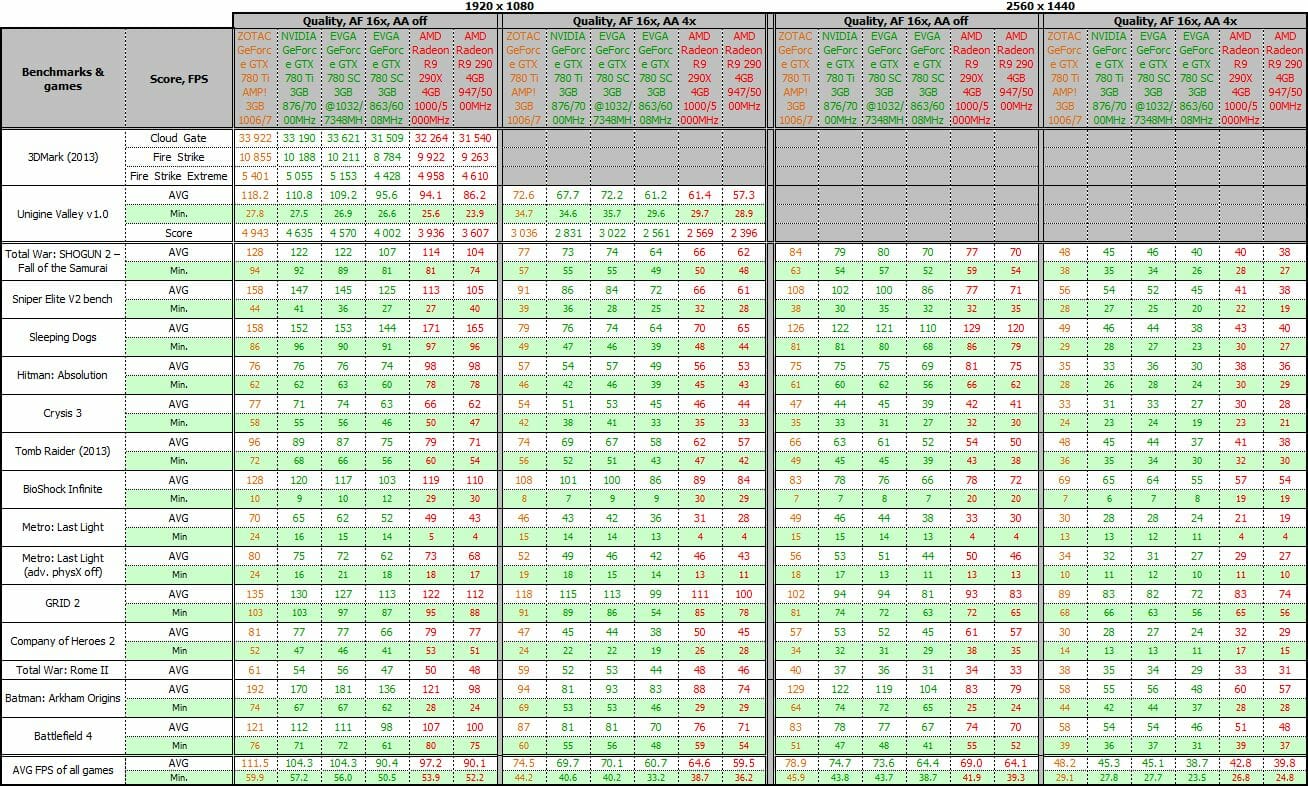
Now let’s move on to our summary charts.
Performance Summary
First, let’s see how faster the Zotac GeForce GTX 780 Ti AMP! Edition (1006/1027/7200 MHz) is in comparison with the reference Nvidia GeForce GTX 780 Ti (876/928/7000 MHz):
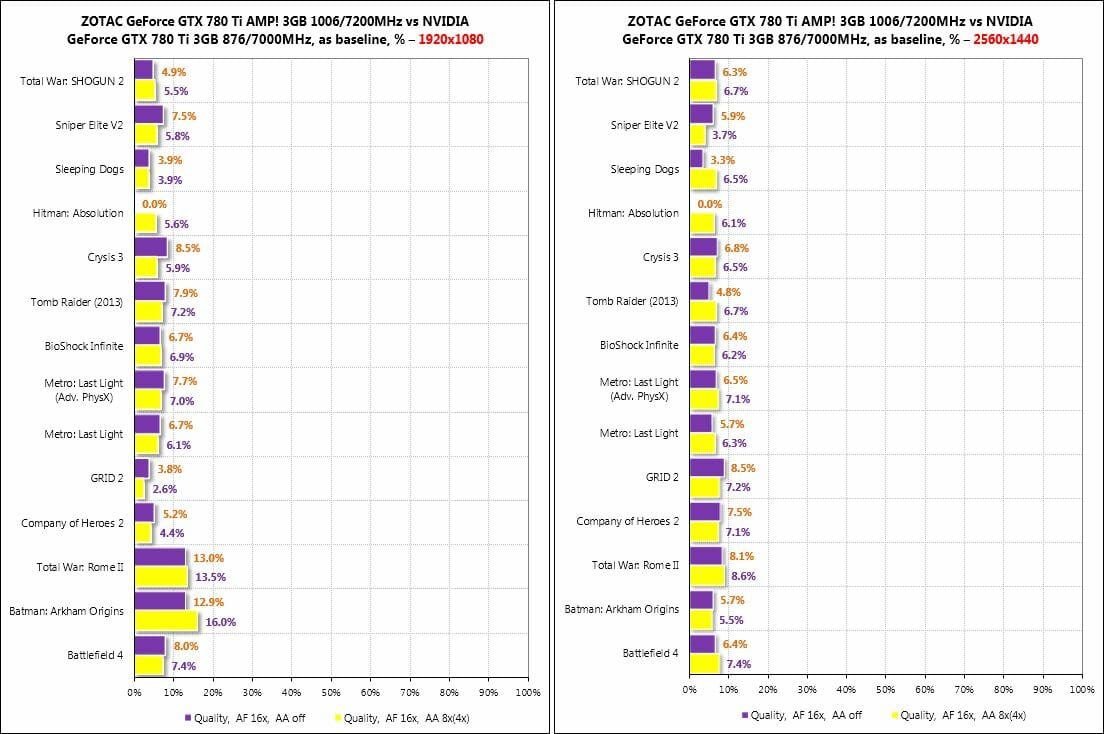
The Zotac is an average 7% faster than the reference card across all of our tests. The maximum advantage can be observed in Total War: Rome II and Batman: Arkham Origins. The gap is the narrowest in the lower-quality mode of GRID 2, Company of Heroes 2 and Hitman: Absolution.
In the next pair of our summary charts we compare the Zotac GeForce GTX 780 Ti AMP! Edition and the EVGA GeForce GTX 780 Superclocked (at 1032/1085/7348 MHz):
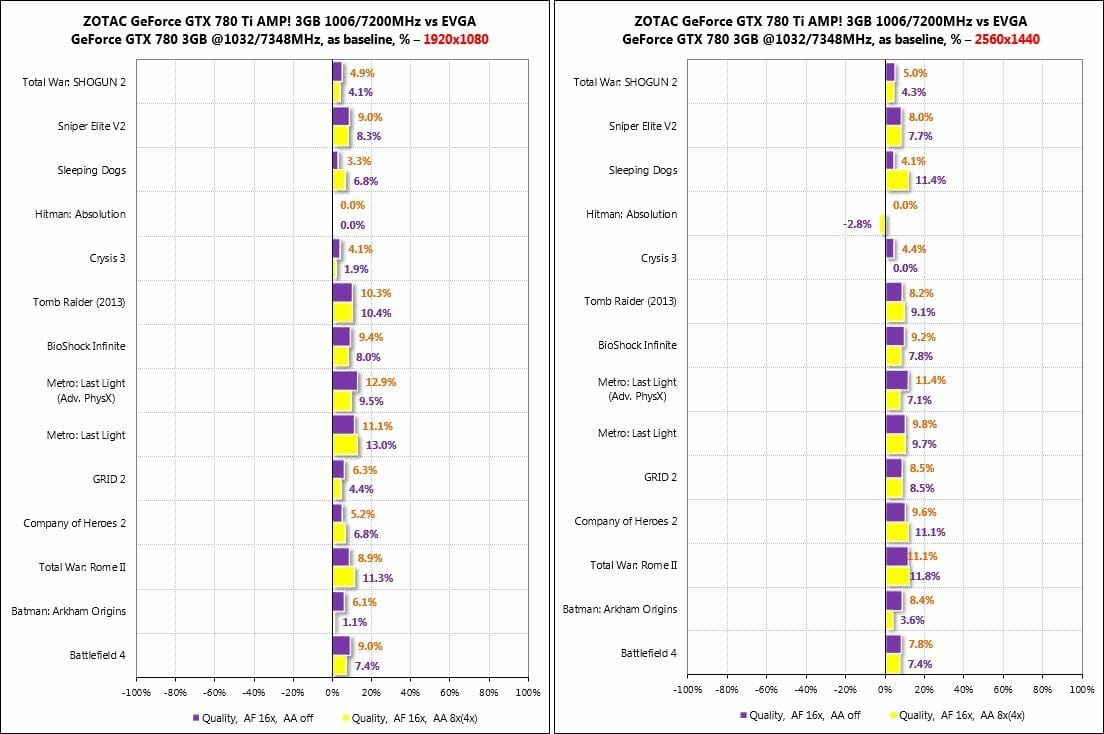
Despite the impressive overclocking potential of the original card from EVGA, the Zotac GeForce GTX 780 Ti AMP! Edition is ahead at its default clock rates in most of the tests, enjoying an average advantage of 6-8%.
We guess these two pairs of diagrams are enough considering that we’ve tested the rest of the cards a number of times in our earlier reviews.
Power Consumption
We measured the power consumption of computer systems with different graphics cards using a multifunctional panel Zalman ZM-MFC3 which can report how much power a computer (the monitor not included) draws from a wall socket. There were two test modes: 2D (editing documents in Microsoft Word and web surfing) and 3D (the intro scene of the Swamp level from Crysis 3 running four times in a loop at 2560×1440 with maximum visual quality settings but without MSAA). Here are the results.
As we can see, these configurations are comparable in terms of their power draw. The gap between the most economical and the most voracious system is only 41 watts, which is negligible for computers of that class. As expected, the configuration with Zotac GeForce GTX 780 Ti AMP! Edition has the highest power draw, up to 570 watts at peak loads, which is 41 watts higher than the configuration with reference GTX 780 Ti needs.
We can also add that each of the tested configurations can be powered by a 600W PSU.
Conclusion
The Zotac GeForce GTX 780 Ti AMP! Edition is just the first in our series of reviews of original GK110-based graphics cards, yet we already recommend it to every gamer who wants high performance whatever the cost. This graphics card is pre-overclocked and also has additional GPU overclocking potential. Its Zotac Triple Silencer cooler is more efficient and quieter than the reference card’s. Although not exactly silent, it will satisfy the majority of users in terms of noisiness, too. We guess the noise level, which is average, is in fact the only imperfection in this otherwise excellent product.
But if you don’t like it for some reason, you may want to wait for our next GeForce GTX 780 Ti review!